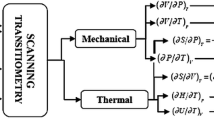Summary
Calorimetry has proven to be of considerable value in the study of macroscopic and microscopic properties of polymers. It provides a tool to understand the vibrational state of the solid state and allows kinetic measurements of processes based on bond rotation. The development of simple to operate intermediate precision instruments on a commercial level raises the hope that much more quantitative data will be forthcoming in the future.
Zusammenfassung
Die beiden hauptsächlichsten Bewegungsarten in Hochpolymeren sind Oszillationen und gehemmte Rotationen. Oszillationen haben häufig Zeitkonstanten von 10−12 bis 10−13 sec. Messungen der spezifischen Wärme gekoppelt mit theoretischen Berechnungen des Schwingungsspektrums ermöglichen eine Diskussion der Bewegungszustände kristalliner und glasiger Hochpolymere.
Die gehemmten Rotationen sind die Basis vieler zeitabhängiger Prozesse. Die Zeitkonstanten haben keine obere Begrenzung. Kalorische Messungen ermöglichten, am Polyäthylen die typische spezifische Wärme des gehinderten Rotators zu ermitteln. Der kalorische Haupteffekt, der beim Einsetzen gehinderter Rotationen in der Polymerkette auftritt, ist jedoch die Änderung der Konformation und die damit verbundene Enthalpieänderung. Gläser zeigen einen Sprung in der spezifischen Wärme im Glasumwandlungsbereich. Kristalline Hochpolymere schmelzen in einem engen Temperaturbereich mit der dazugehörigen Absorption der Schmelzwärme. Beide Prozesse zeigen eine deutliche Zeitabhängigkeit, die kalorisch gemessen werden kann.
In den letzten Jahren hat sich die dynamische Kalorimetrie zu einem wichtigen Instrument der Analyse von Polymerstrukturen entwickelt. Hauptsächlich erfolgte dies auf der Basis des Studiums der zeitabhängigen Prozesse in kristallinen und amorphen Hochpolymeren.
Similar content being viewed by others
References
Wunderlich, B., Polymer5, 125, 611 (1964).
Prigogine, I., Thermodynamics of Irreversible Processes, 2nd Ed. (New York 1961).
O'Neill, M. J., Anal. Chem.36, 1238 (1964);E. S. Watson, M. J. O'Neill, J. Justin, andN. Brenner, Anal. Chem.36, 1233 (1964).
Smothers, W. J. andY. Chiang, Handbook of Differential Thermal Analysis (New York 1966).
O'Neill, M. J., Anal. Chem.38, 1331 (1966).
Wunderlich, B., andC. M, Cormier, J. Polymer Sci., (to be published).
Wunderlich, B., J. Phys. Chem.69, 2078 (1965).
Hellmuth, E. andB. Wunderlich, J. Appl. Phys.36, 3039 (1965).
Müller, F. H. andH. Martin, Kolloid-Z.172, 97 (1960).
Weissberger, A., Technique of Organic Chemistry Vol. 1, Part 1, Physical Methods of Organic Chemistry, 3rd Ed. (New York 1959).
A derivation and discussion of the vibrational specific heats can be found inM. Blackman's article on Specific Heats of Solids, in:S. Flügge, Handbuch der Physik, VII-1 Berlin-Göttingen-Heidelberg 1965).
Landolt-Börnstein, Zahlenwerte und Funktionen, Vol. 2, Part 4 (1961).
Tarasov, V. V. andG. A. Yunitskii, Zh. Fiz. Khim.39, 2077 (1965) (See there for earlier papers).
Tarasov, V. V., New Problems in the Physics of Glass (Moscow 1959).
Wunderlich, B., J. Chem. Phys.37, 1207 (1962).
Smith, H. M. J., Phil. Trans. A241, 105 (1948).
Young, J. A. andJ. U. Koppel, J. Chem. Phys.42, 357 (1965).
Wunderlich, B., J. Chem. Phys.37, 1203 (1962).
Wunderlich, B. andH. Baur, Fortschr. Hochpolymeren Forschg. (to be published).
Wunderlich, B., J. Chem. Phys.37, 2429 (1962).
Tool, A. Q. andC. G. Eichlin, J. Res. Natl. Bur. Stand.6, 523(1930).
Volkenshtein, M. V., Yu. Volkenshtein andA. Sharanov, Vysokomolekul Soedin3, 1739 (1961).Wunderlich, B. andD. Bodily, J. Polymer Sci., Part C,6, 137 (1964).
Wunderlich, B., J. Phys. Chem.64, 1052 (1960).
Wunderlich, B., D. Bodily andM. H. Kaplan, J. Appl. Phys.35, 95 (1964).
Mandelkern, L., Crystallization of Polymers (New York 1964).
Wunderlich, B., L. Melillo, C. M. Cormier, T. Davidson, andG. Snyder, J. Macromol. Sci. Phys. (to be published).
Hellmuth, E., B. Wunderlich, andJ. M. Rankin, Appl. Polymer Symp.2, 101 (1966).
Liberti, F., Thesis (Troy 1967).
Jaffe, M. andB. Wunderlich, Kolloid-Z. and Z. Polymere216–217, 203 (1967).
Author information
Authors and Affiliations
Additional information
Motion in Crystalline and Amorphous High Polymers Deduced from Caloric Measurements.
Rights and permissions
About this article
Cite this article
Wunderlich, B. Beweglichkeit in kristallinen und amorphen Hochpolymeren aus kalorischen Messungen. Kolloid-Z.u.Z.Polymere 231, 605–621 (1969). https://doi.org/10.1007/BF01500017
Received:
Issue Date:
DOI: https://doi.org/10.1007/BF01500017




